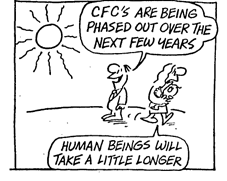
by Sharon Beder
Introduction
Human Skin Cancer
Sunscreen and Fabric
The Mouse Model of Cancer
Studies Using Skin Tissue
Drugs and Sunlight
Plant and Algae Growth
Conclusion
Glossary
Bibliography
International Legislation
Some countries that discharge CFCs and halons may not be the worst affected by the consequences so regulation at a national level is not sufficient. Global problems such as ozone depletion require international action. Legislation at the international level is difficult because of the lack of any single governing body that can impose standards and the inability to send in police to enforce regulations. Basically, nations have to agree to the legislation and that is why such laws often take years to negotiate and come into force.
Negotiations for the treaty to protect the ozone layer has been relatively swift. The Vienna Convention was signed in 1985 by 20 nations, including the major CFC producing countries. It was updated in 1987 after more scientific evidence highlighted the need for tougher action. The 1987 agreement was called the Montreal Protocol and required emissions of CFCs to be reduced by half by 1998 and halon emissions to not increase past 1986 levels. Low income countries were able to defer these reductions since they produced very small amounts to start with. This Protocol was able to come into force at the beginning of 1989.
The Protocol contained provisions for it to be updated as new evidence came to hand and indeed it was again updated in 1990 when 93 nations agreed to stop using CFCs by the year 2000 and the list of ozone depleting chemicals covered by the protocol was extended. Also these nations agreed to set aside money to help low income nations meet the conditions by buying substitutes for CFCs and halons.
Various reasons have been put forward for the speedy agreement to the Montreal Protocol. These include the role played by the international scientific community, environmental groups, and the United Nations Environmental Programme; the pressure of public opinion in key countries such as the United States; the development of economical substitutes for CFCs; the uncontroversial scientific evidence of damage already done; and the inclusion of financial provisions for helping low income nations meet their obligations.

cartoon by Ron Tandberg in the Sydney Morning Herald
Nevertheless not everyone is happy with the Montreal Protocol as it now stands. The Australian government sent a youth delegation to the latest negotiations and they were reported to be extremely disappointed with the outcome. They wanted to see CFCs phased out by 1995 (a view now supported by the United Nations Environmental Program) and thought that the various governments represented at the meeting had bowed to pressure from industry in allowing production to continue till the year 2000. Susanna Begg, a 17 year-old member of the Australian youth delegation who addressed the conference, said the debate had largely been guided “by short-sighted commercial gains and national self interest.” (SMH 4/7/90)
The position of Greenpeace is even more hardline:
In calling for an immediate 100% phaseout in production of CFCs, Greenpeace takes the view that nearly all uses of CFCs are either non-essential, or can be substituted for by using available technology. In some medical and other life-saving uses where CFCs do not have any viable alternative, Greenpeace believes that the need for these can be met from the considerable store of CFCs already produced by recycling CFCs already in use.
Saradha Thanarasjasingam, a Malaysian legal researcher, claims in the magazine Third World Resurgence that the main obstacle to CFC-substitution “is cost, not chemistry”. Industry has many billions of dollars invested in equipment that is dependent on CFC-products and much of this equipment has a life-span of more than 20 years. This equipment would have to be replaced prematurely. She claims that outmoded and untested CFCs are being dumped on Third World counties because the Montreal Protocol allows these countries a longer period before CFCs have to be phased out. (April 1992)
Another problem with the Montreal Protocol is that it allows countries to increase their production of CFCs and halons in line with quantities of these chemicals that are destroyed. The method currently used for this, high temperature incineration, creates other problems through the release of toxic material to the environment. Destruction of CFCs allows companies to continue to produce CFCs rather than force the reuse of those already in existence.

a cartoon by Mark David in the Eastern Herald, 19/12/90.
Will the Montreal Protocol be enough? In April 1992 the newsletter dedicated to Ozone Layer Protection and the Implementation of the Montreal Protocol, OzonAction, reported that the ozone hole was being depleted faster than predicted and that there had been significant increases in ground level UVB radiation in Antarctica and Australia. And in June 1992 it reported that ozone was decreasing over Europe between 15% and 20% in January and February and in Antarctica levels were as low as 50% in spring and UV-B radiation had increased by 1.5%.
Researchers have also found that the reproduction rate of plankton has fallen by at least 6-12% in Antarctica as a consequence of the ozone hole. Plankton are most productive in the spring which is when the ozone hole is at its worst. This could have a dramatic effect on the rest of the food chain, including fish, penguins and seals. (New Scientist, 29/2/92) Ozone depletion is now evident at all lattitudes except the tropics. UN officials claim that speeding up the ban on ozone depleting substances could prevent millions of additional cases of skin cancer and thousands of cases of blindness. (SMH 8/4/92)